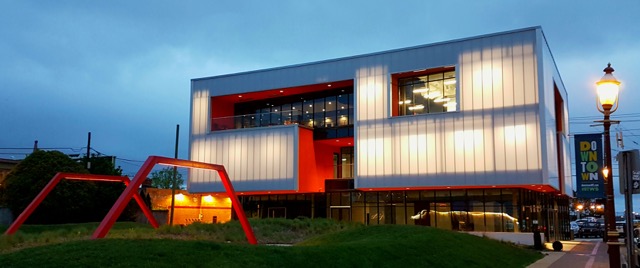By Katy Shick

Tom Hooper’s new film, “The Danish Girl”, chronicles the struggle of a man in the late 1920s to become the woman he knows himself to be. Based on the novel by David Ebershoff, “The Danish” Girl is the fictionalized account of Einar Wegener, a Danish landscape artist, who became one of the first individuals to undergo sexual reassignment surgery. Einar, played by Eddie Redmayne, begins, however, as a man happily married to a fellow artist, Gerda, played by Alicia Vikander, and they hope to have a baby soon. His career is blossoming; hers is not. As the story opens, Gerda stands in front of one of Einar’s paintings. An older woman leans in and asks her if she wouldn’t love to be able to paint as well. Although a fine painter herself, Gerda cannot find a market for her portraits. That is, until Lili, Einar’s female alter ego, comes into their lives.
Einar discovers unexpected feelings one day when Gerda pressures him into donning a pair of stockings and ladies’ slippers to stand in as a model for a painting she needs to finish quickly. He is both enraptured and frightened by the joy he feels at witnessing himself dressed in women’s clothing. Awakened by these feelings, Einar begins to tentatively introduce them to Gerda, who is also fascinated by this new subject whom she can “submit to her gaze.” Together, they create Lili, who becomes both their muses. Gerda’s paintings of Lili launch her career, taking her to Paris. Lili herself becomes Einar’s canvas, and he brings her to life with the meticulous brushstrokes of the artist, using lipstick and mascara as his medium.
As Lili awakens, however, Einar begins to move from the objective artist to the subject itself, eventually giving up painting altogether, having become the very art he tried to create. Einar repeatedly painted the same landscape, ever as unsatisfied with his painting as he was with himself. As a result, Einar the observer disappears, and Lili the performer takes over. And, Greda, who was originally inspired by Lili, tragically watches her husband slip out of her fingers.
Eddie Redmayne’s performance as Einar/Lili is exquisite, perfectly capturing his fear and her joy. The night of Lili’s debut at an artist’s ball, Redmayne’s Lili is both thrilled and terrified to be the center of everyone’s attention, and she reveals her thoughts through her lovely eyes, which alternately twinkle and well up with tears. Early in Lili’s emergence Redmayne manages to portray both Lili and Einar, Lili in the eyes and Einar from the chin down. As Einar becomes more comfortable with Lili, Redmayne captures the wonder Einar feels as he gazes upon Lili. While in Paris, Einar visits a peep show to study the performer’s movements and draws her attention. As he and the woman on display begin to perform together, the terror fades and pure joy remains as Lili takes over in a beautifully acted and filmed scene.
Alicia Vikander likewise delivers a powerful performance as Gerda. As Redmayne expresses Lili through her eyes, Vikander reveals Gerda’s pain and confusion through her tears. Vikander portrays Gerda’s bravery with subtlety and rarely voices her feelings. Her emotions are complex; therefore, she doesn’t embrace Lili as Einar does. Although she loves her husband and wants to make him happy, she understands that his happiness will destroy hers. She even brings him his childhood love played by Matthias Schoenaerts in hopes that she can hang on to Einar and not lose him to Lili. Instead, she introduces a man who threatens to pull her even further from Einar. As she begins to have feelings for Shoenaerts’ Hans, she pulls away despite his promise of a physical relationship and the renewed hope for children because to accept his love would be to lose Einar entirely. If the film stumbles at all, it is with Gerda. Whereas Redmayne’s face portrays all that Lili experiences, Vikander’s face cannot possibly express everything that Gerda must feel. If the writers had given her a chance to speak more, to explain the complexity of her thoughts that need more than tears to express, Vikander could perhaps have matched Redmayne’s performance.
Beyond the beautiful performances, “The Danish Girl” is also a lovely work of visual art. Einar and Gerda’s Denmark is painted in soft blues and browns and golden yellows. Their apartment, sparsely decorated, serves as a fitting background to the still life-like quality of their lives before Lili—empty and lonely. When Einar and Gerda travel to Paris, they are surrounded by the rich and sumptuous rooms of their new apartment, and Lili blossoms into her own woman. The film ends in the peaceful countryside of Germany where Einar undergoes his surgery followed by the stark but beautiful landscapes that Einar spent his career attempting to capture. Here, as Gerda and Hans watch Lili’s scarf taken by the breeze out to sea, is where Einar’s spirit seems best suited—natural, unbridled, and wondrous.
The Danish Girl is a film about the private lives of Einar and Gerda Wegener and their love. It is not a political film, although their lives eventually are thrust into the public view, bringing to their story the misunderstanding and mistreatment transgender individuals have always had to face. Einar risks institutionalization or a lobotomy when he seeks out medical help. His surgeon tells him he will most likely die from his sexual reassignment surgery. But, that isn’t the focus of this film. It is Einar, Lili, and Gerda’s love for each other. Sadly, Einar never realizes his goal of having his own children someday, as his journey was cut too short to answer many of the questions the rest of his life as a woman would ask. When he recreates himself as a woman, he makes Lili an object for others to gaze upon and a performer to delight others. He never gets to share Gerda’s experience as a woman free of identifying herself through the eyes of a man. When he tells her that he feels “entirely myself,” he has only begun his journey and never gets the chance to live as the woman he has always wanted to know.

Katy Shick teaches English at North Forsyth High School in Winston-Salem. An avid life long movie fan, she has been reviewing films for family, friends, and the captive audiences of her classroom for decades.
“The Danish Girl” is still playing at a/perture. You can find showtimes and purchase tickets HERE.







